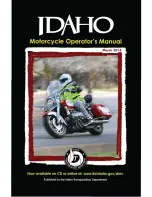
Illustration
2
Showing gear pedal Indica-
t o r which upon assembly is
set to record the various
gears also neutral position.
U p o n
re-assembly a f t e r
dismantling for any pur-
pose t h e indicator pointer
should be correctly re-set
fo r f u t u r e reference.
STOPPING T H E ENGINE—SINGLES A N D STANDARD T W I N
To stop the engine, close the throttle, TURN OFF IGNITION. Before leaving the
machine, turn off the fuel supply.
STOPPING T H E ENGINE—MAGNET O MODELS
To stop the engine, close the throttle, depress the magneto cut-out press switch on the
contact breaker cover and keep it depressed until the engine has ceased to revolve.
O N T H E ROAD
Having started and warmed up the engine, take the machine off the stand, sit astride it,
free the clutch by pulling up the large lever on the left bar and engage the lowest gear.
Next, slowly release the clutch lever and the machine will commence to move forward.
As it does this, the engine speed will tend to drop as it picks up the load so it will be
necessary to increase the throttle opening, gradually, to keep the engine speed gently
rising.
When well under way, disengage the clutch, slightly close the throttle, engage second
gear and release the clutch lever, then open up the throttle to increase the speed of
the machine. Repeat these operations in order to engage third and top gears.
To engage a higher gear the pedal is pressed downward with the toe and a lower gear is
obtained by raising the pedal with the instep. To engage first gear from the neutral
position, the pedal is therefore raised. After each pedal movement, internal springs
return the pedal to its normal horizontal position.
The pedal must be moved to the full extent of its travel when selecting a gear, either
up or down. It must not be "stamped down" or jabbed, but firmly and decisively
moved till it stops. A half-hearted movement may not give full engagement. Keep
the foot off the pedal when driving and between each gear change because, unless the
lever can freely return to its normal central position, the next gear cannot be engaged.
R U N N I N G I N T H E ENGINE
Selective assembly of parts, such as pistons, cylinders and big end assemblies, etc., are
used in the process of manufacture. It is an established fact that if the engine, when
new, is run in as it should be, engine trouble or seizures will not occur.
It is a natural desire to learn the capabilities of one's machine, similarly it can be irritating
to be overtaken by a rider of a machine fitted with a smaller capacity engine. Never-
theless, the owner of a new machine must, in his own interest, strictly adhere to the
principles of running in, which will result in a quieter engine, with a better performance
than a similar machine owned by a rider who is unwilling to drive with restraint during
the initial stage of running in.
The load imposed on the engine is governed by the amount of throttle that is used, and
the makers of your machine, know from experience, that if the throttle or twist grip is
not opened in excess of
one-third of its total movement
for the first 1,000 miles independent
of road speed, the engine cannot be overloaded.
After this distance the amount of throttle can be progressively increased until the
machine has covered 2,000 miles.
10
Содержание 16
Страница 2: ......
Страница 21: ...Illustration 8 Cross section of engine showing oil galleries oil passages and release valve 19...
Страница 47: ...Illustration 22 Carburetter details in assembly order 45...
Страница 59: ...Exploded view of Teledraulic Forks Illustration 29 57...
Страница 73: ...71...
Страница 74: ...72...
Страница 87: ...Illustration 48 Wiring diagram Singles SINGLE CYLINDER MODELS 85...
Страница 88: ...Illustration 49 Wiring diagram Magneto Twins TWIN CYLINDER MODELS 86...
Страница 89: ...Illustration 50 Wiring diagram Alternator Twins 87...
Страница 99: ...Illustration 52 TOOL KIT 97...
Страница 103: ......
Страница 104: ......













































